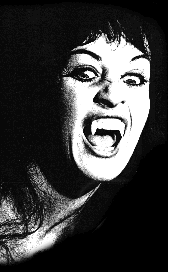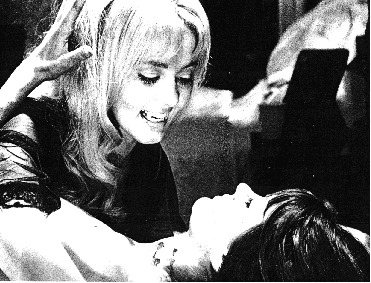
LAIR OF THE SPIDER-WOMEN
performance proposal by Zachàr Laskewicz
|
|
New Music-Theatre for five performers and film Collaborative project between Zachar Laskewicz (composer) Anouk De Clercq (film-maker) and Rakini (dancer/choreographer) Introduction This is a new music-theatre composition which has five female performers interacting with one another, the film, instruments and recorded sound on tape, both of their own voices and pre-recorded music. It forms as a whole a twelve-part polyphony of sound, action, text, music and movement. The Lair of the Spider-Women is a complex multimedial composition with many contrasting themes, some of which are described below. It uses as a foundation point the image of the undead ‘brides’ of Dracula who wait eternally in his crypt beneath the earth. What do they do when the imposing male figure is not there? Would they endlessly wander the tombs awaiting his return? We think not. Instead, in this music-theatre composition, these figures become vital living representations of primeval strength. Themes which return during the course of the work are that of the ritual as vivid means of female communion, the cyclical relationships between a woman, her body and blood (menstruation), and fear and angst women have of themselves and men have of woman. Here the image of the ‘penetrating’ woman, using sharp teeth instead of a penis, penetrates sexually into the bodily flesh of another, drawing blood, reducing the victim of any power they may have made: the man is made impotent by the penetrating female vampire. These themes hide other more delicate and dangerous taboos which must not be lightly dealt with. Female strength has for thousands of years been silenced by men who have felt threatened through their incomprehension. This work is based on exploring horror, using as a basis the stereotypical scenes evoked in some lesser known films, but by exploring these themes to witness this type of horror, a metatheatre work is created in which issues are brought to light concerning the importance of the horror genre to the way people are influenced by their environment and what they expect from it. We are, very much, a product of what we fear, and in this composition we will be bringing some of these issues to light—having at the same time an enormously good time doing it.
Structure
of composition —Each of the different
following movements are not clearly divided: there is always at least one
performer who remains in the section which is preceding. Part 1
: The Awakening —The opening image is
that of dracula’s wives waiting in the cellar. —The first character
awakens, perhaps via cue from the film, and thereafter proceeds to act on
the other vampires in a ritual fashion. —Perhaps this first
vampire performs the act of blessing a vat of water wish is thrown onto
the vampires functioning to awaken them. This is ritual act one. —This is echoed on
film by relating the blessing of the holy WATER with an act of
PURIFICATION. —As the vampires
awaken, they begin to perform movements on stage. This is cued by vocal development
on the pre-recorded tape and visual imagery. —Perhaps as every
vampire wakes, the shape disappears from the film imager. —Opening section shows
a vista of fragments from the whole work, at least in the fragmented
movements of the women. —Begins with utters of
horrifying words, especially adjectives: vile, disgust, terror,
seething, horror, spasm, rip, tear, sear, Part
2 : The Consecration of the Space —Using
sacred sand, the performance place is consecrated, initially by throwing
sand in general and then by placing sand at particular places. This is echoed on the film by the
construction of a circle which is marked by particular points. —Here
FIRE is used as a filmic symbol which is related to the lighting of the
candles. —The
sand is TRANSCENDED into a new level of being thanks to the function of
FIRE. Part
3 : The malicious vagina —This
has one of the vampires representing what men most fear. This is represented filmically by
a flesh-eating vagina. —On stage woman lies
with her legs pulled apart (perhaps by two of the others) Blood starts dripping from above (menstruatie), legs in opposite direction from the audience. On the video a man eating vagina: or a head emerges out of the vagina: horrific image, what all men fear, the flesh eating vagina. Vagina with teeth. One also thinks of giving birth and the pain evoked.
Part
4 : The Construction of the Ritual
Shape —One
of the awakened vampires performs the function of anointing the holy space
of the ritual with the holy water blessed in part one. —Other
vampires move out of the central space as this ritual occurs, although
they keep up with their initial movements. —A
combination of FIRE and WATER is used to create the shape of the spider
goddess who will be evoked in the part six. The shape is of a spider, but that
is only represented on film.
On stage points of the shape are placed ritually. Part
5 : The Penetrating Women, the
bodiless fuck —Pieces from lesbian
vampire films. Discussing the
act of vampirism, the head-less fuck. In a way contrasting to the
malicious vagina.
—Possibly
passionate/possibly subtle lesbian interaction between two vampires Lesbian scene has blood dripping on breasts, then taken over on film as chaos reers its ugly head.
Part
6 : The Reading of the Text —Use
the vampire head in the dream from An American Werewolf in London. —Player
3 moves ritually to the stand positioned just behind the ritualized shape
to read the text. The
beginning of this section occurs when 2 and 4 have moved and picked up
instruments which were previously draped with sheets. —Player three reads in
a guttural language, passages out of which will be used in hysterical
gesticulations later and also quoted on tape (perhaps from the beginning
and even during the recitation).
—On the film,
translation of text is demonstrated, perhaps echoed in English or some of
the words or sounds are echoed with visual imagery, perhaps of someone
else reading the text, or in polyphony with the same actor reading the
text so that it becomes a jumbled and confusing mixture of spoken word and
mixed languages in addition to gesticular sound. —When the performer
leaves the altar positioned behind the circle a state of relative
cacophony has been reached which has the vampires uttering, gesticulating
and moving sparodically and (at least in appearance) chaotically. Some element of similarity, such
as jerked position from the hypnotic post-climactic dance which are
perhaps echoed on film. Part
7 : The Rite —The vampires move
independently of one another, although a ritual chant results in their
coming together, becoming a powerful symbol of female power. —Before the lights go
out at the end of the ritual build up, a trance-like repetition of texts
takes place, becoming louder and louder, chaos in the background (sounds),
and continually more and more spiders on the film. This is the Mother-spider vampire
goddess. —Male victim (singer)
picked from the audience, is ritually sacrificed, becomes spider goddess –
transvestite – [?] relives and accompanies ritual, where the women are
moving slowly Part
8 :
The Conclusion —After resuscitation
of the male vampire (or female goddess who is represented filmically, not
necessarily by a male), the ritual chant dissipates and the voices are
taken over on the recording, leaving the vampires on the five points of
the circle performing a series of very slow movements, elegant, almost
Javanese like. —This is complex
happening: discourse of sound, film, females vampires and male vampires
almost seem to go concurrently.
Lighting fades out very gradually and composition is finished. —Female vampires begin
singing, but their singing is echoed on the recording by similar
voices. Perhaps atonal until
one by one the singers hear their whispering voice on tape on which they
stop singing an atonal note, which is picked up by an instrument or a
tonal voice on the tape part.
The ending is concurrent , but haunting. —When the male character enters, the lights have already dissipated to nothing. This happens suddenly at the end of the ritual event. He comes and lies in the middle of the circle.
The
following actions can also take place polyphonically on stage and/or
film: —The
construction of an effigy from sticks and string. The film could show the shape, or
it all could be represented on film. —Each vampire has a
[short] story to tell, although the longest text is read by performer 3
which is accompanied musically by the other performers. —Perhaps during an
attack the vampires attack members of the audience, hypnotically
convincing them and then orgiastically sucking them dry. —Incense is lighted
before or during the performance at three to five different places on
stage.
Musical and Theatrical
Structure —During the reading,
performer 2 and 4 are performing violin and flute respectively, which is
picked up by the tape as the ritual begins to occur around the ritual
structure centre-stage. —There are a number of
different expressions which the vampires can individualise. These expressions are made up of
certain sounds and certain emotional states. A list is included below of these
sounds and movements, standing still or moving forward, standing, sitting
or crawling. A single name is
applied to each one. (1) The Hunger (2) Gasping for
breath (3) Near orgasmic
excitement (4) Animal-like
crawling (5) The sacrifice (6) The desperation (7) The vampire
attack —Music cycle at the
end involves the tenor singing slow melody in time with movement. —Polyphony of 12
lines: (i) film (ii) – (vi)
actors/dancers/musicians on stage (vii) – (xi) voices on
tape (xii) synthesizer Lair of the Spider Women is a new music-theatre composition created as part of a three-part work known as: ABYSMAL RITES: a Trilogy of Terror Three compositions by Zachar Laskewicz Composed and Produced by the Nachtschimmen Theatre Collective © Zachar Laskewicz, April 2000.
Planned Time Schedule for Project: June 2001: Rakini, Laskewicz and De Clercq workshopping project July 2001: Rehearsal with actors August-September 2001: Performances in Belgium
|







